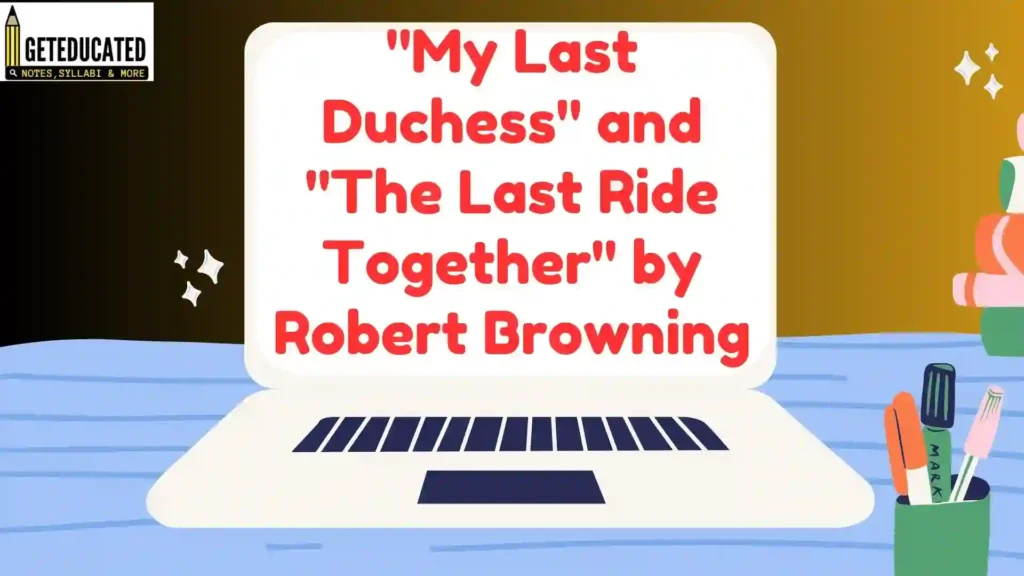
Analysis of Robert Browning’s My Last Duchess : Robert Browning was a 19th-century poet renowned for his use of dramatic monologues and psychological insight. His poems are still studied and appreciated today for their complexity, lyricism, and engagement with timeless themes. Robert Browning is one of the greatest Victorian poets who employed dramatic monologue as the medium of expression very skillfully and effectively. Therefore, whenever the term ‘dramatic monologue’ is mentioned, the name of Robert Browning immediately comes to our mind. His “My Last Duchess” has been considered as one of the finest dramatic monologue produced in the arena of English poetry.
The poet’s inspiration for this poem came from the Duke and Duchess Ferarra. The Duchess died under very suspicious circumstances. She was married at fourteen and dead by seventeen. Browning uses these suspicious circumstances as inspiration for a poem that dives deep into the mind of a powerful Duke of Ferarra who wishes to control his wife in every aspect of her life, including her feelings.
The poem presents a typical crafty character of the age of Renaissance, in the person of the Duke of Ferrara, who is the speaker of the monologue. He shows a portrait of his previous wife, who is dead, to the messenger of a Count whose daughter he wishes to marry. While commenting on the nature of the Duchess he unconsciously reveals the working of his own mind.
This setting also hints at the fact that the poem’s story is historical. A duke had murdered his seventeen-year-old wife after three years of marriage, and married another girl. The main character and speaker of the poem is Duke Alfonso II of Ferrara. The other person listening to him is the marriage agent sent by the Count of another place called Tyrol.
The duke is talking about the painting on the wall while preparing to go down to meet the Tyrol, the father of the proposed girl, and other people who have come to finalize the new marriage proposal. The poem looks like a piece of small-talk, but it is meant to reveal a story of oppression, jealousy, pride, corruption, murder and the greed for dowry. The theme of this poem is the wide gap between the so-called high culture and ‘low’ personal behaviour of the upper class during the Renaissance Italy. The purpose of the poet is to expose the real character of the duke and satirize the culture that he represents.
The monologue is designed in such a way that it reveals the true character of the duke who is having a small-talk with a visitor. As the duke is preparing to go downstairs, probably putting on his clothes, he sees that the messenger is looking at the paintings on the wall. He begins to talk about the painting of his previous wife (the duchess). He says that it was a painting by the famous Italian painter brother Pandolf. The way he repeats the name and uses ‘fra’ or ‘brother’ before the artist’s name suggests that the duke is trying to impress the visitor with his intimacy with artists.
Suggested Reading :
Critical Analysis of the Poem – The Last Ride Together
Similarly, we see that he is trying to give the impression of being an art-lover (aesthete) when he describes the painting with the words of an art- critic – “the depth and passion in the earnest glance…… reproduce the faint halfflush that fades along the throat…”. Then he boasts about his art of speaking by indirectly saying that he doesn’t have the skill of saying small things in the proper manner. But that is another example of his egotism. He claims that he is such a powerful man that no one has dared to ask him about the red spot on the cheek of the duchess. But we see that he is such a mean, evil-minded, jealous and cynical man who thinks that if his wife looks at or smiles at visitors and any other males, it is because of her sexual excitement with them. He guesses that the painter’s smalltalk had caused “the spot of joy” to appear on her cheek!
Then he boasts about his ‘nine hundred years old name, and complains that the duchess did not give special regards to that. With normal people, that doesn’t count in a marital relationship, because everyone’s husband is a husband first of all and it is not necessary to address him by his status-name. He says that she used to bring the red spot of joy on her cheek and he gave a “favorable” look on her breast. The duke is a shameless tyrant who cannot think of anything positive; most probably because he is evil minded himself. He says that “her looks went everywhere”, that she would thank and appreciate anything or anyone, that she was too easily impressed, and that she used to smile at anyone who passed by her.
At the climax of the dramatic poem, the Duke reveals that he had killed his previous wife.There are also some dramatic actions in the poem, in the beginning, the duke tells the other man to sit down and look at the picture. Towards the end of the poem, he tells him to stand up: “Will it please you rise?” We also guess other things that the characters must be doing. As the duke is saying all the nasty things about his own wife, the other man seems to try to leave the place! But the duke tells him to wait: ‘Nay, we’ll go down together, sir”. The next moment, we find that he is making the man wait just to give another piece of boasting! He points to a statue and tells his guest that it is his own statue in the form of god Neptune training the sea horse. This also symbolizes this demand for a wife like a ‘trained’ horse. The poem ends with the duke still talking about himself as a great man and a lover of art.
The poem is a superb example of compactness and condensation. Browning’s famous critic, Philips, points out that though the poem consists only of 56 lines the story suggested in it could have covered thousands of pages. In swift, broad strokes of genius, Browning gives us an insight into the Renaissance period, its customs and the unscrupulousness of the rulers of that age.
The poem is interesting from the point of view of metre. It is written in heroic couplet, a style so commonly associated with Pope. But, whereas in Pope, the rhymes are pronounced like regular hammer strokes, here the rhymes are hardly noticeable. The sense runs so smoothly from line to line that the rhymes become muffled or concealed.
Browning’s descriptive genius is in evidence in this poem. Some of the lines present striking word-pictures.
She smiled ……………. the same smile.”
“The depth and passion of its earnest glance’, the ‘spot of joy”, “the faint half flush that dies along her throat, the statue of Neptune ‘tanning a sea horse’ are word-pictures which have a compelling effect on the reader’s imagination. A touch of pathos is noticeable in this poem.
Suggested Reading :
The Lamb and The Tyger Long Questions and Answers
My Last Duchess is one of the greatest dramatic monologues of Browning but it is by no means the only one. Indeed, almost his entire poetry at least his great poetry is written in this form. Browning is the greatest master of this from and is at his best when writing in it. Unlike Shakespeare, he cannot show many characters together in action. His greatness lies in taking hold of a single character and presenting him in such a way that his soul very is laid bare before us. As a critic says, “He would take a character, get inside it and make, it speak in such a way that it expresses its whole personality, history and philosophy.”
In the fifty-six lines of the poem, the poet besides presenting a situation, gives a ruthless analysis of the Duke’s character. His jealously, his greed, his masterlines, nobility of his lineage all are admirable comment – only the Duke speaks. The picture is thus built up with the help of little touches of character which are insignificant in themselves but which gain intensity in this poem.
The main theme in My Last Duchess is the power imbalance between men and women in a patriarchal society. The Duke holds all the power in this relationship; his wife has no say in anything. He controls her fate, even going as far as having her killed because she disobeyed him. Other themes in this poem include jealousy, possessiveness, and justice.
The painting of the Duchess is symbolic of the Duke’s attempt to keep her memory alive and also his control over her. He is unable to accept her death and keeps her image frozen in time. The portrait also serves as a reminder of her obedience and submissiveness; the way in which she looks down shows her humility and acquiescence to the Duke’s authority.
The main idea of My Last Duchess is that men can be tyrannical. In their power and use it to control women in a patriarchal society. The Duke’s possessiveness and jealousy lead him to take drastic measures. In order to maintain power over his wife and keep her under his control.
My Last Duchess is a chilling story of power and dominance in a patriarchal society. Through his vivid imagery and powerful characters. Robert Browning brings to life the story of the Duke of Ferrara and his late wife, the Duchess. He shows how easy it can be for a man in a position of power to manipulate and control a woman, with tragic results.

[…] Critical Analysis of the Poem – My Last Duchess […]
[…] Critical Analysis of the Poem – My Last Duchess by Robert Browning […]
[…] The poet’s inspiration for this poem came from the Duke and Duchess Ferarra. The Duchess died under very suspicious circumstances. She was married at fourteen and dead by seventeen. Browning uses these suspicious circumstances as inspiration for a poem that dives deep into the mind of a powerful Duke of Ferarra who wishes to control his wife in every aspect of her life, including her feelings. The poem presents a typical crafty character of the age of Renaissance, in the person of the Duke of Ferrara, who is the speaker of the monologue. He shows a portrait of his previous wife, who is dead, to the messenger of a Count whose daughter he wishes to marry. While commenting on the nature of the Duchess he unconsciously reveals the working of his own mind. … (Read More) […]